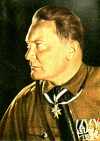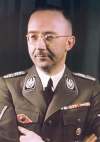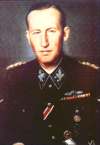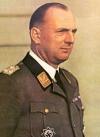 |
| Hermann Göring |
The Oxford Encyclopedia defines a police state as "(that) in which a national police organization,
often secret, is under the direct control of an authoritarian government, whose political purposes it
serves, sometimes to the extent of becoming a state within a state." The Nazi police state was to
develop far beyond this definition. It became not only an instrument of repression and control in
Germany, but also a continent-wide system of terror and murder.
The creation of a Political Police force was an early objective of National Socialism. Prussia was the
largest state in Germany, including as it did the capital,
Berlin, as well as other
major cities. On
26 April 1933,
Hermann Göring,
initially acting as Prussian Minister of the Interior and then as Prussian Minister President,
established the Secret State Police Office (
Geheimes Staatspolizeiamt - Gestapa), which
evolved into the Secret State Police (
Geheime Staatspolizei - Gestapo). The Prussian police
force had consisted of the uniformed or Order Police (
Ordnungpolizei - Orpo) and the
plain clothed Criminal Police (
Kriminalpolizei – Kripo) which included the Political Police
(
Staatspolizei – Stapo). It was the political sections of the
Kripo, together with the
Stapo that were taken over and became the
Gestapo, headed by
Rudolf Diels.
At the same time as
Göring was creating the
Gestapo in
Prussia,
Heinrich Himmler was consolidating power as
Police President of Bavaria, a position to which he had been appointed on
9 March 1933.
Reinhard Heydrich occupied the position of chief of
Department VI of the Bavarian Police, the political division.
Heydrich
was also head of the Security Service of the
Reichsführer-SS (
Sicherheitsdienst - SD),
the intelligence branch of the SS, an office he had effectively created in
1931.
The SD was intended to
keep the opponents of the NSDAP under surveillance, to provide protection for the leadership and to
fend off possible dangers from within the Party. As
Himmler stated:
"The SD will discover the enemies of the National Socialist concept and it will initiate countermeasures
through the official police authorities."
 |
| Heinrich Himmler |
Throughout
1933-34,
Himmler gradually gained control
of all of the German States' police forces, except for that of Prussia, which remained under
Göring's jurisdiction, until on
1 April 1934,
Diels was removed as head of the
Gestapo,
signalling the accession of
Himmler on
20 April
as head of a unified national police force.
Heydrich was
appointed head of the
Gestapo and immediately began a programme of drastic reorganisation.
With effect from the
summer of 1934, the SD was declared the sole intelligence
service of the Party.
Whilst the other branches of the police were employees of the State, members of the SD were
employed by the Party, which paid their salaries. Most senior
Gestapo men were recruited from
among professional police officers; in contrast, the SD attracted an elite of ambitious intellectuals –
lawyers, economists, professors of political science and the like. Although
Heydrich now controlled both the SD and the
Gestapo
there was considerable overlapping in the areas of responsibility of the two organisations. This
could sometimes lead to bewildering conflicts of interests. The SD had a monopoly of political
intelligence, whilst only the
Gestapo had the authority to carry out arrests or interrogations
and send people to concentration camps. But the
Gestapo still carried out its own intelligence
work, which it could only do with information supplied by the SD. Both the
Gestapo and the
SD were responsible for "churches, sects, other religious and ideological associations, pacifism,
Jews, right-wing movements, other anti-State groups, economics and the press".
 |
| Reinhard Heydrich |
Clearly, some kind of rationalisation was required in the interest of greater efficiency. This was achieved
when on
17 June 1936, the Party post of the
Reichsführer-SS was
amalgamated with the
government office of Chief of the German Police, providing
Himmler
with the title of
Reichsführer-SS und Chef der Deutschen Polizei (RFSS u ChDtPol).
Technically,
Himmler was subordinate to
Wilhelm Frick, the Minister of the Interior, but in practice he
acknowledged only one superior –
Adolf Hitler. The
police were divided into two main branches: the "Main Office of the Security Police", (
Sicherheitspolizei – Sipo)
headed by
Heydrich, included the
Gestapo and the
Kripo.
The "Main Office of General Police" (
Ordnungpolizei - Orpo) headed by
Kurt Daluege was responsible for the Municipal
Police (
Schutzpolizei), the Rural Police (
Gendarmerie) and Local Police
(
Gemeindepolizei).
Despite their all-seeing, all-knowing reputation, compared to other police departments neither the
Gestapo nor the SD was ever numerically great. Post-war research has revealed that in the typical
German city of
Krefeld, between
1937-41 there
were no more than 12-13
Gestapo officers for 170,000 inhabitants, a ratio of one officer for every
10,000–15,000 citizens.
Outside of major conurbations there were often no
Gestapo personnel at all. In such localities, the
Gendarmerie or the
Schutzpolizei conducted the police work performed by the
Gestapo in the cities. The SD were even fewer in number. Both organisations relied upon a
network of agents and informers to maintain their terrifying character. To a large extent, therefore, it could
be said that the German population policed itself.
 |
| Prinz-Albrecht-Straße |
The final major reorganisation of the police occurred on
27 September 1939, when
Himmler issued a decree creating the Reich Security Main Office
(
Reichssicherheitshauptamt – RSHA), fusing the
Sipo and SD, with
Heydrich as head of the new organisation. Thus
was created a monstrous bureaucracy that was to oppress and terrorise Europe.
Heinrich Müller was placed in charge
of the
Gestapo, with
Arthur Nebe
as head of the
Kripo. The headquarters of the
RSHA were situated at the former
Gestapo building at the
Prinz-Albrecht-Straße 8 in
Berlin, with other offices spread across the city and branches
throughout Germany. Much to the displeasure of
Heydrich,
who wanted to control of all of the police forces, the
Orpo remained outside of the ambit of the
RSHA.
 |
| Police Battalion |
The completed police state was now in place and ready to begin its campaign of wholesale
atrocity and murder. Six
Einsatzgruppen, numbering some 1,800-2,250 SD,
Sipo and SS
members, followed closely in the wake of the
Wehrmacht as it invaded Poland.
Selected by the
RSHA, they were responsible for killing some 15,000 Jews and members of the
Polish intelligentsia during the months following the invasion. With the commencement of "
Unternehmen
Barbarossa" in
June 1941, this figure was to be dwarfed by the activities
of the four
Einsatzgruppen
and their assistants in eastern Poland and the Soviet Union. As in so many other cases of Nazi genocide, the
precise number of victims will never be known, but it has been estimated that by
spring 1943, as many
as 1,250,000 Jews and hundreds of thousands of other Soviet Nationals had been murdered by the
Einsatzgruppen.
A typical
Einsatzgruppe of this period might consist of about 1,000 personnel, made up of 100
Gestapo, 30-35 SD, 40-50
Kripo, 130
Orpo, 80 auxiliary policeman, 350
Waffen-SS, 150 drivers and mechanics, plus interpreters, radio operators, clerks, and some female staff.
The various police branches involved in the
Einsatzgruppen became largely indistinguishable.
 |
| Kurt Daluege |
The activities of the
Einsatzgruppen were supplemented by the police battalions and reserve
police battalions of the
Ordnungspolizei. These had been created by
Daluege from a pool of reservists, volunteers and
Volksdeutsche.
By
mid-1940, the number of
Ordnungpolizei had grown to 244,500. 101 police
battalions had been
created, each consisting of about 500 men. As has been well documented, they were to play a significant
role in the shooting and deportation to extermination camps of the Jews of Poland and the Soviet Union.
However, the
Einsatzgruppen and police battalions were only one aspect of the Nazi police
state. Responsible for the surveillance and control of the local populace everywhere, the
Sipo-SD
acted to ruthlessly crush any sign of opposition to the regime or act of resistance. They were an essential
component in the establishment, administration and eventual liquidation of the ghettos. Their record
of brutality throughout Europe is without equal.
Unlike the other torturers and executioners, most of the camp staffs of
Aktion Reinhard
had been recruited from the T4 euthanasia operation. Although some, like
Franz Stangl and
Christian Wirth had once been career policemen, they were now employed not
by the
RSHA or the
Orpo,
but by the "Führer Chancellery" (
Kanzlei des Führers – KdF). All those serving
in the death camps of
Belzec, Sobibor and
Treblinka were given a minimum SS rank of Sergeant
(
SS-Unterscharführer) and came under the command of
Odilo Globocnik as
Lublin
SS and Police Leader (
SS- und Polizeiführer - SSPF). Yet in the labyrinthine world of the Nazi
police state, it was
Wirth who dictated the modus operandi of
Aktion Reinhard and
Wirth, whilst subordinate to
Globocnik, was simultaneously taking instructions from
Viktor Brack and
Philipp Bouhler
of the
KdF – and thus providing a direct route to
Hitler
that bypassed
Himmler and the
RSHA.
The trainloads of victims to
Auschwitz - Birkenau earmarked
for "special treatment" (
Sonderbehandlung)
were designated "
RSHA Transports." The
RSHA was also responsible for organising
transports from outside of the
Generalgouvernement to the transit ghettos of
Izbica, Piaski, Rejowiec and to the camps at
Sobibor and
Trawniki,
amongst other destinations. Although transports from
within the
Generalgouvernement to the death camps were planned and coordinated by the
Aktion Reinhard headquarters in
Lublin and arranged by the German
railroad authorities in Poland (
Generaldirektion der Ostbahnen), the
RSHA in
Berlin were kept informed about them and of the progress
of
Aktion Reinhard. Recently
discovered in the former Soviet archives in
Moscow, the
1941 index of files for
Adolf Eichmann's Department IVB4 of the
RSHA clearly indicates
the extent of the
complicity of the RSHA in all aspects of "The Final Solution."
The overall number of victims of the Nazi police state is incalculable. In the
Reich and in
every occupied country, it left a trail of death, destruction and misery behind it. By the war's end, many
of the perpetrators were dead. Some faced justice in post-war trials, often many years after their crimes
had been committed. Others simply disappeared. The majority were never called to account or at
most received lenient sentences, particularly from West German courts, and lived out the remainder
of their lives in freedom.
Sources:
Gutman, Israel, ed.
Encyclopedia of the Holocaust, Macmillan Publishing Company, New York, 1990
Padfield, Peter.
Himmler – Reichsführer-SS, Macmillan Publishers Limited, London, 1991
Höhne, Heinz.
The Order Of The Death's Head, Pan Books Limited, London, 1972
Johnson, Eric.
The Nazi Terror, John Murray, London, 2002
Butler, Rupert.
An Illustrated History of the Gestapo, BCA, London, 1992
Reinhard Rürup, ed.
Topography of Terror, Verlag Willmuth Arenhövel, Berlin, 2000
Browning, Christopher R.
Ordinary Men, HarperCollins, New York, 1993
Goldhagen Daniel Jonah.
Hitler's Willing Executioners, Little, Brown and Company, London, 1996
Oxford Encyclopedia, Oxford University Press, 1998
Arad, Yitzhak.
Belzec, Sobibor, Treblinka - The Operation Reinhard Death Camps, Indiana
University Press, Bloomington and Indianapolis, 1987
Gutman, Yisrael and Berenbaum, Michael, eds.
Anatomy of the Auschwitz Death Camp, Indiana
University Press, Bloomington and Indianapolis, 1998
Cesarani, David.
Eichmann – His Life and Crimes, William Heinemann, London, 2004
© ARC 2005












